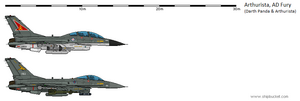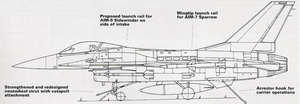Arthuristan Dynamics Fury
| Arthuristan Dynamics Fury | |
|---|---|

| |
| Fleet Air Arm Sea Furies | |
| Role | Multi-role fighter bomber |
| Manufacturer | Arthuristan Dynamics |
| First flight | 1977 |
| Introduction | 1981 |
| Status | In service |
| Primary user | Fleet Air Arm, Commonwealth Air Force |
The Arthuristan Dynamics Fury and the navalised Sea Fury are a family of multi-role fighter bombers in service with the Arthuristan Fleet Air Arm and Commonwealth Air Force, derived from the Mi-10.2 Taguato of Rezese design. Although slated to be replaced by the UFC Tempest, significant numbers remain in service.
Origins
Arthurista's flying services were concerned with the replacement of three models of combat aircraft in the 1970's. At the time, the Belfrasian Continental Reaper filled the niche of heavy air superiority fighter, the Arthuristan Dynamics Mercury served as a long-range heavy strike aircraft, whilst the Greenwich Super Tigress was the primary light fighter and ground attack platform. Due to the relatively benign defence environment at the time, the right wing National Liberal Party wished to relieve some budgetary pressure by forcing the military to 'neck down' from three different models to one aircraft capable of performing all their roles.
This led to considerable protests among the services, and the decision would later be reversed when a new Labour government, primarily concerned with the conservation of jobs in the Arthuristan aviation industry, was elected in 1973. Under the new government, the Arthuristan Dynamics Cyclone was procured, and work began to develop the STOVL Arthuristan Dynamics Kestrel. However, the niche defined for the Fury remained, and considerable development work had already been completed. The aircraft was successfully prototyped and entered production in the late-1970's.
Design
Compared with its diminuitive Rezese antecedent, the Fury features a measurably larger airframe, which is about 1m longer and possesses a wing area which is roughly 23% larger, allowing it to carry additional fuel. The navalised Sea Fury is designed to be resistant to salt-water corrosion and has a robustified undercarriage and airframe designed to withstand the stress of catapult launch and arrestor-wire landings. In order to counteract the weight gain, a more powerful turbofan engine is installed. Able to develop 75kn of thrust 'dry' and 130kn with afterburner, it was upon its introduction the most powerful single-engined fighter in the world.
The large airframe and powerful engine enable the Fury to have a considerable combat radius. When equipped solely with air-to-air ordnance and drop tanks, it has an air interception range of more than 1,200km, whilst naval strike range with two drop tanks, two air-to-air missiles and four ACM-2 Renove or ACM-13 Lilith is around 833km.
The Fury was the first Arthuristan fighter aircraft to feature a number of important innovations, including fly-by-wire control, relaxed stability and a glass-cockpit.
Fury FG.1
The first configuration of the aircraft, the Fury FG.1, was equipped with a Blue Vanguard pulse doppler multi-function radar. This was intended to be a lightweight, relatively austere radar set, albeit featuring look-down/shoot-down and track-while-scan capabilities, enabling it to carry beyond-visual range missiles such as the Sky Flash. It also had ground-mapping and sea-search capabilities which enables it to launch long-range stand-off weapons such as the ACM-2 Renove in either its anti-ship or land-attack variants.
The Fury was also highly capable in delivering iron bombs and cluster bombs accurately and, with the assistance of a laser designator such as the Pave Spike, deliver laser-guided bombs. In order to carry out low-altitude strike missions without the benefit of a FLIR or terrain-following radar, the FG.1 uses a combination of an altimetre and terrain-conforming software in order to avoid so-called 'controlled flight into terrain'.
Fury FGR.2
The FGR.2 was a comprehensive upgrade program which was carried out in the early-1990's. Its most important feature was the Blue Vantage radar, an advanced pulse-doppler radar which is in technological terms a close cousin of the Blue Vixen radar installed on later variants of the Sea Kestrel. This made the aircraft compatible with the AIM-120 AMRAAM. It has a track-while-scan mode for up to ten targets as well as a six-on-six AMRAAM-engagement capability. Compared to the legacy Blue Vanguard, its aerial detection range is enhanced by 25%. It is a low-probability of intercept radar which randomises its output pattern in order to deceive enemy radar-warning receivers.
The radar is incrementally improved since the FGR.2's introduction. In due course, the Blue Vantage gained a synthetic aperture radar image mode, with a moving target indicator capability. Its ability to counter enemy electronic warfare capabilities was also progressively enhanced.
The FGR.2 also gained other offensive capabilities. It features an IRST and helmet-mounted display. It is also compatible with other stand-off munitions such as the AGM-65 Maverick, the ACM-2 Renove anti-ship missile, as well as anti-radiation missiles such as the ALARM. Further enhancing its strike capabilities was the night-vision goggle adaptations carried out to the cockpit.
Although not a dedicated strike aircraft, the Fury FGR.2 also acquired the ability to designate its own laser-guided munitions through the use of the AAQ-14 targeting pod.
The FGR.2 gains the 'R' designation by virtue of its ability to carry out reconnaissance missions with the integration of the Digital Joint Reconnaissance Pod. Navigation accuracy was improved with the use of SATNAV. Link 16 was incorporated.
The aircraft's electronic warfare and countermeasures systems were also extensively overhauled to operate as an integrated, automated suite, rather than discrete elements operating simultaneously but independently. It features a new radar-warning receiver, pod-mounted jammers, as well as towed decoy, whilst retaining the original flare/chaff dispenser equipment.
Later in the 1990's, Conformal fuel tanks (CFT) were made available to extend the aircraft's endurance without occupying sparse hardpoints with drop tanks.
Strike Fury FGR.2(S)
The Strike Fury program was conceived in the early-80's and began to be implemented in the late-80's. It was intended to develop an all-weather interdictor capable of low-altitude penetration of defended airspace, as a replacement for the venerable Arthuristan Dynamics Mercury. The Strike Fury was procured by the Commonwealth Air Force only. The Fleet Air Arm declined to participate in the program.
The Strike Fury was based on the airframe and avionics of a baseline, two-seater FGR.2 aircraft. It incorporates the Belfrasian LANTIRN targeting and navigation pods. The latter unit possesses a combination of terrain-following radar and forward-looking infra red system, enabling the aircraft to perform precision-strikes at tree-top altitude in all weather conditions using laser- and electro-optical guided munitions. Thus equipped, the Strike Fury fully replaced the Mercury as Arthurista's prime strike aircraft.
The diminution in the endurance of the aircraft as the result of it being smaller and possessing less fuel than the Mercury, or indeed compared to a single-seater Fury owing to the need to accomodate a second seat, was partially offset by the development of a large, 2,000 litre drop tank with a bulbous head, a pair of which may be carried by the aircraft. Later, the incorporation of conformal fuel tanks ('CFT') further mitigated the range issue.
Despite its optimisation as a strike aircraft, the Strike Fury retains the air combat capabilities of the baseline Fury and is perfectly capable of carrying out interception, combat air patrol or offensive counter-air functions, although the slight increase in weight did compromise the fighter's kinematic capabilities to a minor degree compared to the baseline version.
In the late-1990's, the LANTIRN targeting pod was replaced by the Yisraeli LITENING, although the original navigation pod remains in use.
Proposal for Fury FGR.3
The FGR.3 was designed for Arthuristan Dynamics' original unsuccessful bid for a 4.5 generation multirole fighter, losing to the UFC Tempest. It features a new generation active electronically scanned array radar (likely the Mark 3 which equips the Tempest FGR.2 which was itself partially developed from the FGR.2's Blue Vantage as well as the Sea Kestrel's Blue Vixen), a new 25mm gun, a new engine which develops 144kn of thrust with afterburner, conformal fuel tanks, Diverterless supersonic inlet, thrust-vectoring engine nozzle and a comprehensively overhaulled electronic warfare suite, including BriteCloud countermeasures.
The model remains on offer to export customers. Furthermore, owing to the significant costs overruns of the Tempest procurement program, the CAF is seriously considering upgrading the remaining FGR.2's to the FGR.3 configuration as a more economical alternative to buying new Tempests.
Specifications (FGR.2)
- Length: 16m
- Wingspan: 10.1m
- Height: 4.96m
- Crew: 1-2
- Empty weight: 9,525kg
- Powerplants: 1 x Rollers Model 500 turbofan, 75kn 'dry', 130kn with afterburner
- Top speed: Mach 2 at altitude
- Armaments: 1x 30mm revolver cannon with 150 rounds, 8,000kg external stores, 2x wingtip launch rails, 8x under-wing pylons, 3x fuselage pylons
- Combat radius: 1,200km with drop tanks (air interception), 833km (naval strike with 4x anti-ship missiles, 2x drop tanks, 2x anti-air missiles)
- Sensors: Blue Vantage radar, Mark 17 IRST, targeting pods
- Countermeasures: RWR, chaff/flare dispensers


